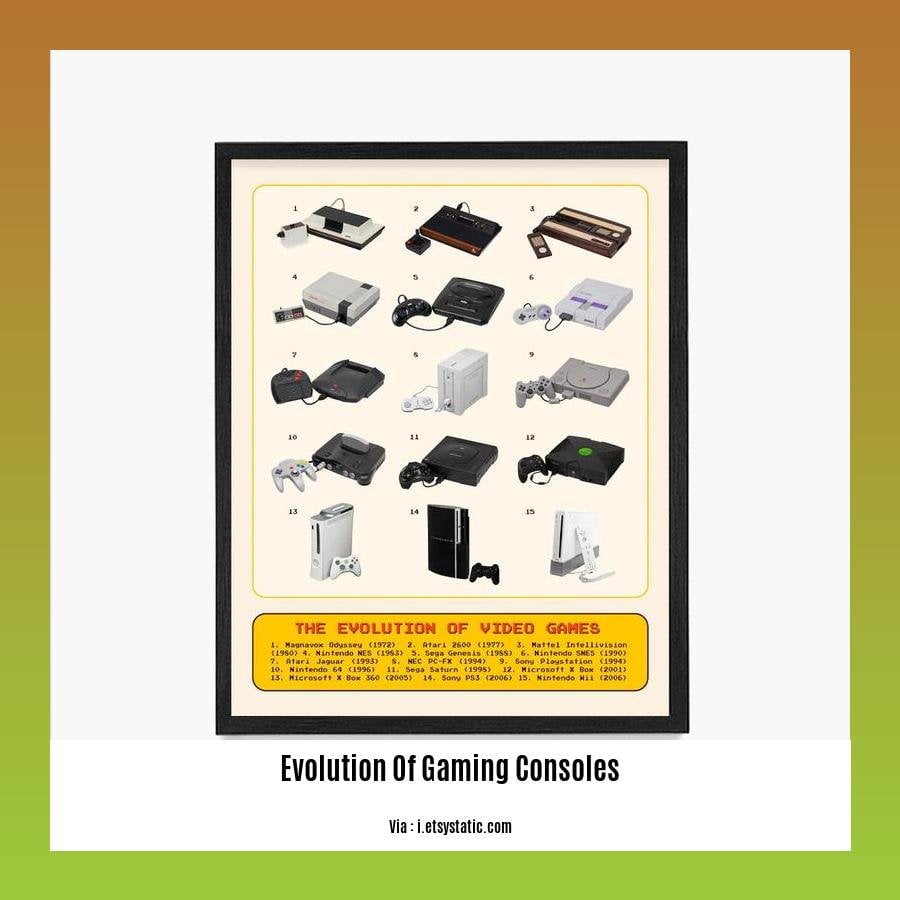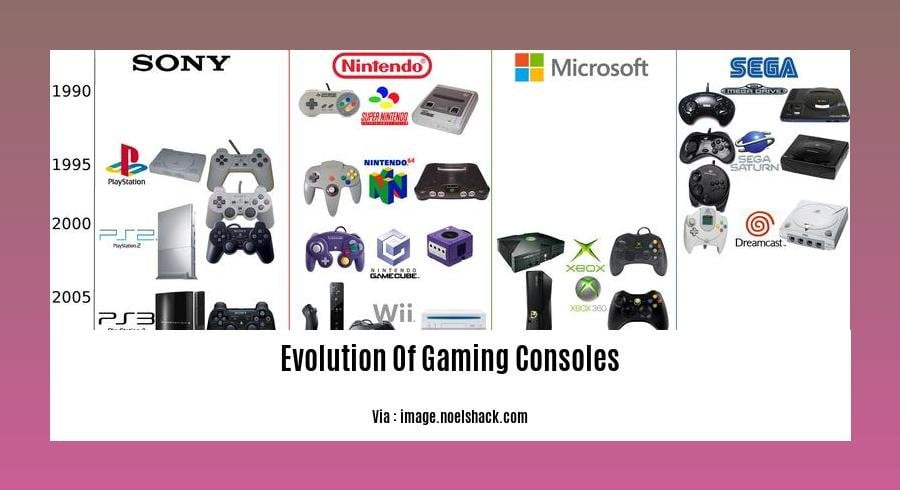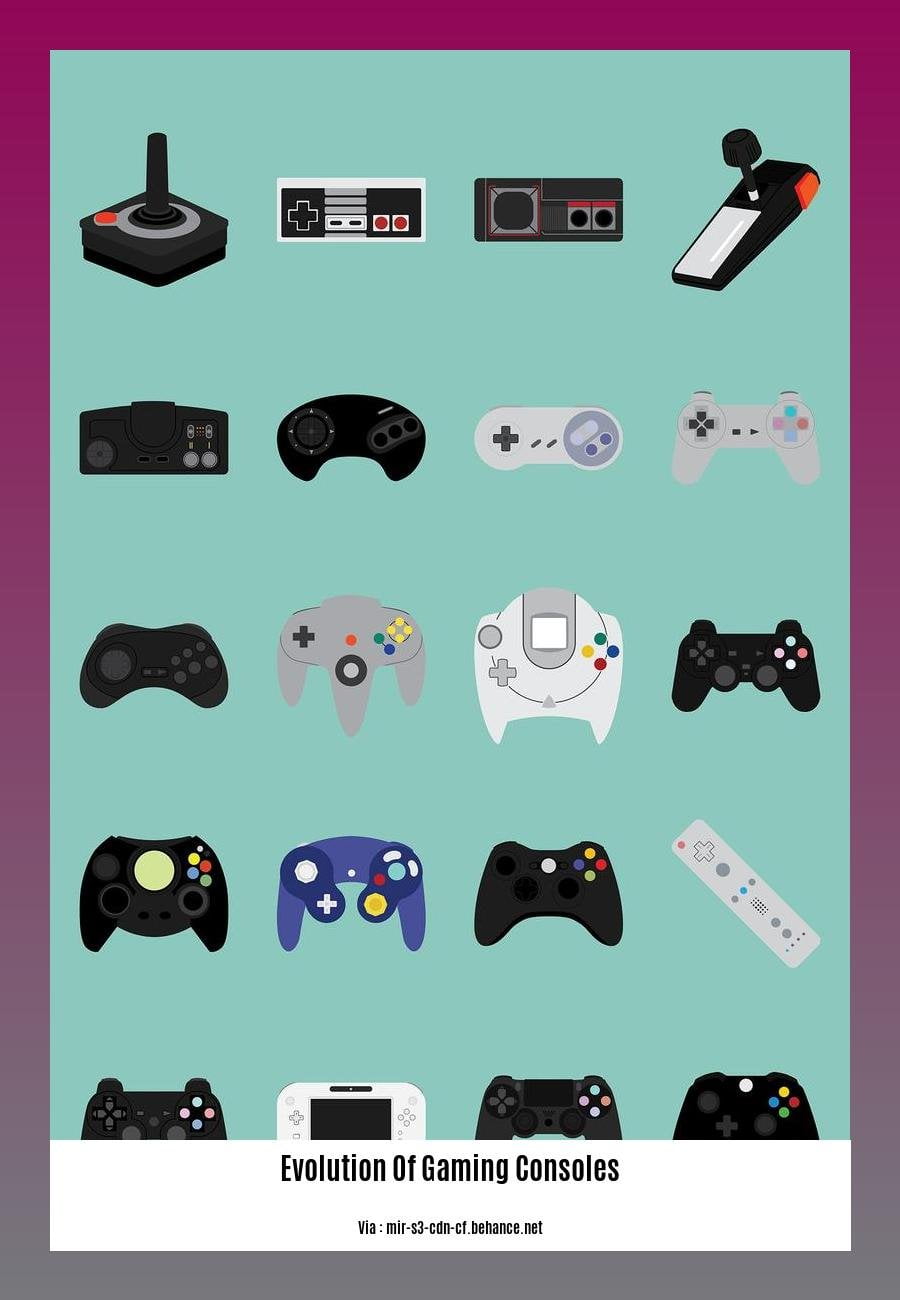Get ready to embark on a thrilling journey through the evolution of gaming consoles with “The Evolution of Gaming Consoles: A Journey Through Technological Advancements and Gaming Excellence.” In this article, we’ll delve into the remarkable advancements that have transformed gaming from a niche hobby to a global phenomenon.
Key Takeaways:
- The evolution of gaming consoles has progressed through eight distinct generations.
- Each generation introduced significant advancements in hardware capabilities and software innovations.
- The early generations laid the foundation for the immersive experiences enjoyed by gamers today.
- The latest consoles offer unparalleled graphical fidelity, immersive sound, and robust online multiplayer functionality.
- The future of gaming consoles holds exciting possibilities, with advancements in cloud gaming and artificial intelligence on the horizon.
Evolution of Gaming Consoles: A Technological Odyssey

From the Dawn of Pixels to Virtual Reality
The evolution of gaming consoles has been a remarkable journey marked by technological advancements and gaming excellence. From the rudimentary graphics of the first generation to the immersive experiences of today, consoles have revolutionized home entertainment.
The Early Years: First to Third Generation (1972-1992)
The first generation of consoles emerged in the early 1970s, bringing basic games like Pong and Space Invaders to living rooms. The second generation introduced cartridges, expanding game variety. The third generation saw the rise of 8-bit graphics and beloved titles like Super Mario Bros.
The Rise of 3D: Fourth to Sixth Generation (1993-2013)
The fourth generation ushered in 16-bit graphics and the iconic Sega Genesis and Super Nintendo. The fifth generation brought 3D capabilities with the PlayStation and Nintendo 64, while the sixth generation refined 3D gaming with more powerful consoles like the Xbox and PlayStation 2.
High Definition and Motion Controls: Seventh to Eighth Generation (2005-2020)
The seventh generation marked the transition to high-definition graphics with the Xbox 360, PlayStation 3, and Wii. The Wii introduced innovative motion controls, while the eighth generation saw even more powerful consoles like the Xbox One and PlayStation 4, delivering breathtaking visuals and immersive gameplay.
Into the Future: Ninth Generation and Beyond
The ninth generation of consoles, represented by the PlayStation 5 and Xbox Series X/S, continues to push the boundaries with ultra-fast load times, ray tracing, and even more realistic graphics. The future holds even more exciting possibilities, with virtual reality and cloud gaming transforming the gaming landscape once again.
The Lasting Legacy of Gaming Consoles
The evolution of gaming consoles has had a profound impact on our culture. They have brought people together, provided countless hours of entertainment, and fueled the growth of an entire industry. As technology continues to advance, we can expect even more remarkable gaming experiences in the years to come.
Did you know that the history of gaming dates back to the ancient world? From early video games](../early-video-games) like Pong to the latest virtual reality experiences, the evolution of gaming is a fascinating one. And the impact of gaming on society is undeniable. Games can educate, entertain, and even help us to cope with stress.
Evolution of input devices: motion controls, virtual reality
The evolution of input devices in gaming has seen a quantum leap from the days of simple joysticks and D-pads. Today, we’re experiencing the mind-bending immersion of motion controls and virtual reality (VR).
Motion Controls: Bringing Your Body into the Game
Motion controls allow you to control in-game actions with your physical movements. Take the Nintendo Wii, which introduced a revolutionary way to play games with its motion-sensing remote. From swinging a baseball bat to bowling virtual pins, it transformed gameplay into an active, full-body experience.
Virtual Reality: Stepping into Virtual Worlds
Virtual reality headsets take immersion to a whole new level. By strapping on a headset, you’re transported into virtual environments where you can explore, interact, and feel like you’re actually there. VR has opened up countless possibilities, from exploring ancient ruins to battling aliens in outer space.
Key Takeaways:
- Motion controls enhance immersion by allowing players to control in-game actions with their physical movements.
- Virtual reality transports players into virtual environments, creating a truly immersive gaming experience.
- These input devices are revolutionizing gaming, offering unprecedented levels of interactivity and immersion.
Citation:
- The Evolution of Gaming Input Devices
Shift towards digital distribution and streaming services

Gone are the days when we had to physically go to a store to buy a new game. With the shift towards digital distribution and streaming services, gamers can now purchase and play games from the comfort of their own homes.
How did this shift happen?
The rise of the internet and broadband connectivity has made it possible for game developers to distribute their games digitally. This has eliminated the need for physical storefronts and has made games more accessible to gamers. In addition, the increasing popularity of streaming services has made it possible for gamers to play games without having to purchase them.
What are the benefits of digital distribution and streaming services?
There are several benefits of digital distribution and streaming services, including:
- Convenience: Gamers can purchase and play games from the comfort of their own homes.
- Accessibility: Games are more accessible to gamers, regardless of their location.
- Variety: Gamers have access to a wider variety of games than they would if they were limited to physical storefronts.
- Cost: Games are often cheaper when purchased digitally than when purchased physically.
What are the challenges of digital distribution and streaming services?
There are also some challenges associated with digital distribution and streaming services, including:
- Bandwidth requirements: Streaming games can require a lot of bandwidth, which can be a problem for gamers with slow internet connections.
- Latency: Streaming games can also suffer from latency, which can make them unplayable for some gamers.
- Lack of ownership: When you purchase a game digitally, you do not actually own the game. You are only purchasing a license to play the game.
Key Takeaways:
- Digital distribution and streaming services are becoming increasingly popular.
- There are several benefits to using digital distribution and streaming services, including convenience, accessibility, variety, and cost.
- There are also some challenges associated with digital distribution and streaming services, including bandwidth requirements, latency, and lack of ownership.
Relevant URL Source:
The Coming Evolution of the Video Game Industry
Increasing convergence with other entertainment and media platforms
The gaming industry has witnessed a remarkable convergence with other entertainment and media platforms in recent years. This trend has transformed the gaming landscape, creating new opportunities for developers and immersive experiences for players.
One key factor driving this convergence is the rise of social gaming. Platforms like Xbox Live and PlayStation Network have enabled players to connect with friends and compete in online multiplayer games. This social aspect has made gaming more than just a solitary activity, fostering a sense of community and shared experiences.
Cross-platform gaming has also contributed to the convergence with other media platforms. Games like Fortnite and Call of Duty: Warzone allow players to interact with each other regardless of their console or device. This has broken down traditional barriers between gaming platforms and expanded the audience for popular games.
Furthermore, gaming consoles have become more versatile entertainment devices. With the addition of streaming services, apps, and web browsers, consoles now offer a wide range of entertainment options beyond gaming. This has made consoles the hub for many people’s home entertainment needs.
Key Takeaways:
- Social gaming has fostered a sense of community and shared experiences, making gaming more than just a solitary activity.
- Cross-platform gaming has broken down barriers between platforms, expanding the audience for popular games.
- Consoles have become versatile entertainment devices, offering a wide range of options beyond gaming.
Relevant URL Source:
Altman Solon. (2022, April). Consumers Increasingly Choose Gaming Platforms for Social Experiences, Driving Convergence Across Social Media. Retrieved from
FAQ
Q1: What are the key generations in the evolution of gaming consoles?
A1: The evolution of gaming consoles has been marked by distinct generations: First Generation (1972-1977), Second Generation (1976-1984), Third Generation (1983-1992), Fourth Generation (1987-1996), Fifth Generation (1993-2001), Sixth Generation (1998-2013), Seventh Generation (2005-2017), and Eighth Generation (2012-2020).
Q2: How has 3D graphics impacted the gaming industry?
A2: The introduction of 3D graphics in the mid-1990s transformed gaming, creating more realistic and immersive experiences. It allowed developers to create virtual worlds with depth, texture, and lighting effects, significantly enhancing the overall gaming experience.
Q3: What is the impact of the digital shift in gaming?
A3: The digital shift in gaming has revolutionized the industry, moving from physical distribution to digital storefronts and online platforms. This has increased accessibility, reduced costs, and paved the way for the emergence of “Gaming as a Service” models.
Q4: How are gaming platforms evolving into social experiences?
A4: Advancements in technology, particularly online multiplayer capabilities and social media integration, have transformed gaming platforms into social ecosystems. Players can now connect with friends and other gamers worldwide, creating communities, sharing experiences, and enhancing their gameplay.
Q5: What is cloud gaming and its future prospects?
A5: Cloud gaming allows players to stream games directly to their devices without the need for costly hardware. This technology removes hardware limitations and expands accessibility, reducing the entry barriers for many gamers. The cloud gaming market is expected to grow substantially in the coming years, potentially changing the landscape of gaming once again.
- Crypto Quotes’ Red Flags: Avoid Costly Mistakes - June 30, 2025
- Unlock Inspirational Crypto Quotes: Future Predictions - June 30, 2025
- Famous Bitcoin Quotes: A Deep Dive into Crypto’s History - June 30, 2025
















